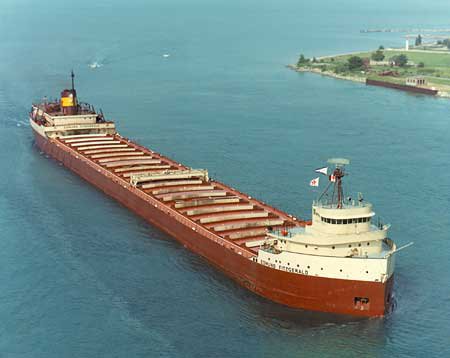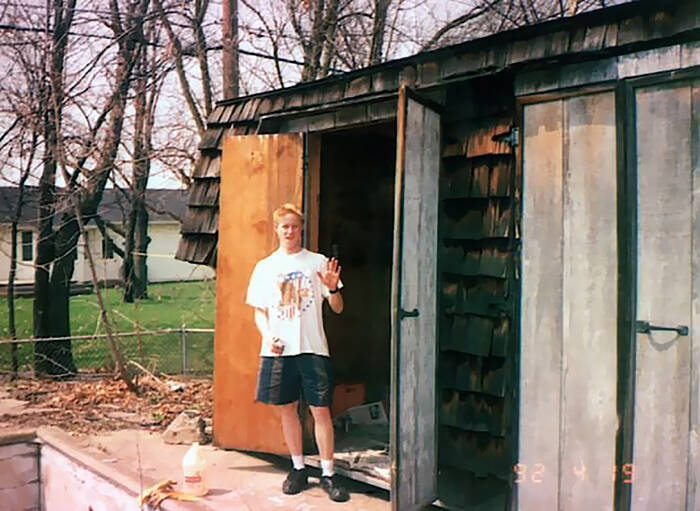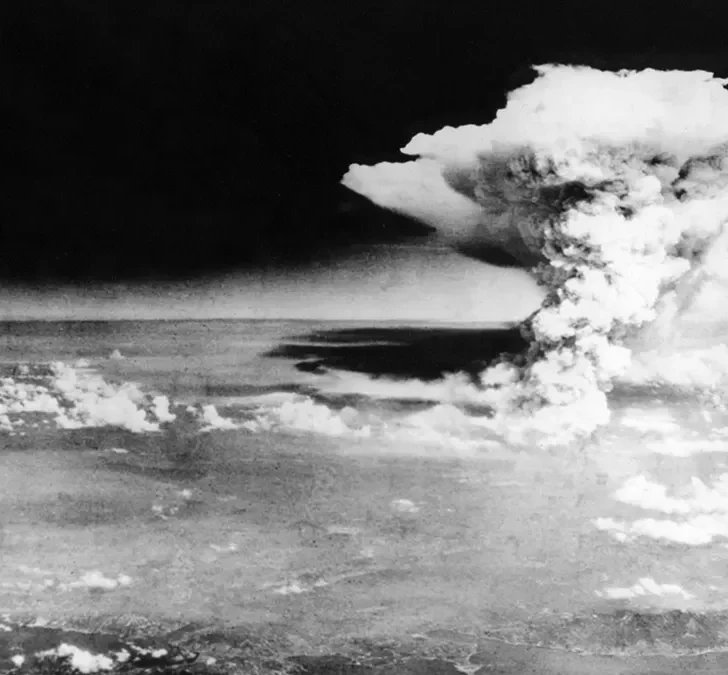The St. Lawrence Seaway is one of the largest and most complex engineering projects of the 19th and 20th centuries.
Canals, locks, and channels allow large vessels to travel from the Atlantic Ocean to the heart of North America.


When it was completed in 1959, this seaway changed the nature of shipping on the Great Lakes.
The St. Lawrence Seaway allows vessels of over 700 feet in length to travel as far west as Minnesota. From the late 1950s, a number of new, large vessels were constructed to carry cargoes throughout the seaway.
The largest of all was the SS Edmund Fitzgerald, which was launched in 1958.
For almost 20 years, this ship traveled more than one million miles on the St. Lawrence Seaway.
It regularly broke records for the weight of cargo it carried. Then, on the afternoon of 10th November 1975, it encountered one of the worst storms ever to hit the region…
The Ship
In 1957 the Northwestern Mutual Life Insurance Company of Wisconsin commissioned the building of a new ship. This was a cargo ship built to the maximum size that could fit within locks of the St. Lawrence Seaway.
The ship was named after the President of Northwestern Mutual, Edmund Fitzgerald.
At 729 feet long, this was the largest ship ever designed for operations within the seaway. It was launched on June 7th, 1958, and undertook its first voyage in September. When the seaway was completed in 1959, the Edmund Fitzgerald began regular cargo operations.
This entailed picking up cargoes of up to 26,000 long tons of taconite (processed iron ore) in Silver Bay, Minnesota.
These were then transported to steel mills in the Lower Lakes area near Detroit and Toledo. A typical voyage to the steel mills took around five days.
Due to its massive size, the SS Edmund Fitzgerald became a well-known sight on the Great Lakes. Crowds would gather to watch the massive ship navigate through locks.
One of the captains, Peter Pulcer, would often entertain spectators by broadcasting a commentary on ship operations.
The Storm
The Great Lakes area is the location for regular winter storms, particularly in November. Cold, dry air coming south from Canada collides with warm, moist air from the Gulf of Mexico.
Warm air from the lakes themselves also contributes to creating regular November Gales.
These can be staggeringly destructive, with hurricane-force winds, heavy snow, and waves of up to 50 feet.
In November 1913, one such gale sank 19 ships and left 19 more driven aground. More than 250 people were killed that year between November 7th – 10th.
During the evening of November 9th, 1975, the National Weather Service (NWS) issued a gale warning for the Great Lakes.
This predicted winds of up to 47 knots (54 mph) and waves of up to 12 feet (3 meters). Early on November 10th, this was upgraded to a storm warning involving winds of up to 50 knots (58 mph).
The Voyage
At around 2:30pm on 9th November, the Edmund Fitzgerald left the harbor in Wisconsin loaded with 26,000 tons of taconite. She was bound for a steel mill near Detroit, Michigan, under the command of Captain Ernest McSorley.
He was aware of the storm warning, but the Edmund Fitzgerald had safely faced worse weather in the past.

By 5:00pm, the Edmund Fitzgerald was following the standard downbound route across the center of Lake Superior. It was close to another large cargo ship, the Arthur M. Anderson, that was following the same route.
Captain McSorley was in regular radio contact with Captain Cooper on the Arthur M. Anderson. As weather predictions from the NWS worsened, Captain McSorley changed course and reduced speed.
Radio messages between the Edmund Fitzgerald and the Arthur M. Anderson were overheard by other ships in the area. Both ships turned north, hoping to get some shelter from the northern shore of the lake.
Up to around 1:00am, the Edmund Fitzgerald had been following the Arthur M. Anderson.
As the Arthur M. Anderson slowed, it was passed by the faster-moving Edmund Fitzgerald. When dawn broke over the storm-tossed lake, it had moved around 10 miles ahead of the other ship.
By the afternoon of 10th November, the weather continued to worsen. Winds grew stronger and heavy snow began to fall. By 2:00pm the Edmund Fitzgerald was around 16 miles ahead of the Arthur M. Anderson but was still in sight.
Both ships were headed for the shelter of Whitefish Bay on the northern shore of the lake. Captain Cooper noted that the Edmund Fitzgerald appeared to pass dangerously close to shallow water at Six Fathom Shoal.
At 2:45pm, the snow continued to increase, and the Edmund Fitzgerald vanished into the white haze ahead.
The bridge crew on the Arthur M. Anderson were able to follow the progress of the other ship on radar. It seemed to safely pass the area of shallow water as it moved north of Caribou Island.
The Disaster
The first warning that the Edmund Fitzgerald was in trouble came at 3:30pm. Captain McSorley radioed Captain Cooper:
“I have a fence rail down, two vents lost or damaged, and a list. I’m checking down. Will you stay by me till I get to Whitefish?”
The fact that the Edmund Fitzgerald was listing indicated that it was taking on water. In heavy weather, that is potentially extremely dangerous.
Cooper asked whether McSorley was running the pumps to remove the water. “Yes, both of them”, was the reply from Captain McSorley.
“Checking down” meant that the Edmund Fitzgerald was reducing speed further to allow the Arthur M. Anderson to catch up. Although there was no indication of imminent danger, Captain McSorley was obviously concerned.
The two ships continued to exchange radio messages as the Arthur M. Anderson slowly drew closer to the Edmund Fitzgerald. There was no indication that the situation on the Edmund Fitzgerald was growing worse.
Then, at around 6:55pm, the Arthur M. Anderson was struck by the first of a series of monstrous waves.
These came from astern and briefly drove the bow of the large freighter beneath the surface. Concerned, at 7:10pm Captain Cooper sent a message to the other ship asking how it was faring.
The response from Captain McSorley was: “We are holding our own.”
By that time, the waves were so large that they intermittently obscured the radar return from the Edmund Fitzgerald. The radar operator on the Arthur M. Anderson saw the “blip” vanish and then reappear several times.
At 7:15pm the radar blip disappeared again. But this time, it didn’t reappear. The Arthur M. Anderson made several attempts to contact the Edmund Fitzgerald by radio, but there was no response.
Abruptly, the weather cleared, and the snow stopped. The crew of the Arthur M. Anderson could see where the Edmund Fitzgerlad had last been located on radar. There was no sign of the ship or its running lights.
Captain Cooper asked other ships in the area to try to make contact with the Edmund Fitzgerald. None succeeded. Cooper then reported his concerns to the Coast Guard.
At 8:00pm, the Coast began an air search for the Edmund Fitzgerald, but nothing was found. By 9:00pm, the Arthur M. Anderson had reached the shelter of Whitefish Bay.
The Coast Guard requested that it return to the last known position of the Edmund Fitzgerald to search for survivors.
Although concerned about facing the still heavy seas, Captain Cooper agreed. The crew of the Arthur M. Anderson found two of the Edmund Fitzgerald’s lifeboats but no survivors.
The Search
A subsequent search of the area recovered the two lifeboats and two liferafts. Both were positively identified as having come from the Edmund Fitzgerald. There was no sign of any of the 29 crew of the missing ship.
On 14th November, a U.S. Navy aircraft using a magnetic anomaly detector picked up a contact. It was located approximately 17 miles north-northwest of Whitefish Point.

A few days later, a Coast Guard vessel using side-scan sonar identified a contact in the same area.
It seemed almost certain that this was a shipwreck, but was it the Edmund Fitzgerald? Since 1816, over 230 ships were known to have sunk off Whitefish Point.
It would not be until May 1976 that the wreck was positively identified as the Edmund Fitzgerald.
Conclusion
The precise cause of the loss of the Edmund Fitzgerald remains a source of debate. The wreck lies in over 500 feet of water, far below the depth to which conventional divers can safely descend. Several theories have been put forward.
Some people claim that the ship was simply overwhelmed by a massive freak wave. Others maintain that the ship may have grounded while crossing Six Fathom Shoal, causing damage that weakened the hull.
There have also been claims that modifications to the ship led to it breaking in half on the surface.
Whatever the cause, we know that the Edmund Fitzgerald must have sunk very quickly. No distress call was received from the ship. She sank so rapidly that most of the crew probably weren’t even aware that there was a serious problem.
The Edmund Fitzgerald was one of the largest ships to sink in the Great Lakes. It is also one of the best-known following the release of the track “The Wreck of the Edmund Fitzgerald.”
This was featured on the hit 1976 album Summertime Dream by Canadian Singer-songwriter Gordon Lightfoot.













Leave a comment